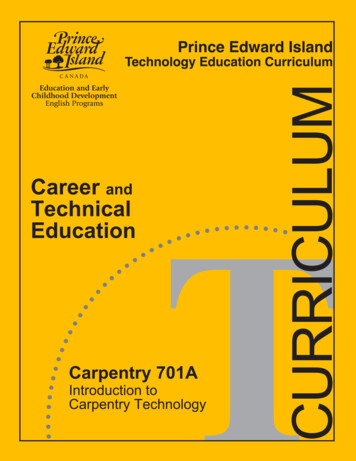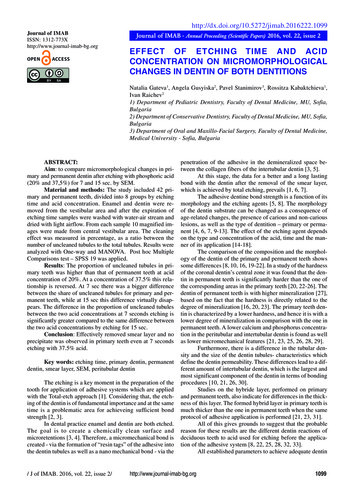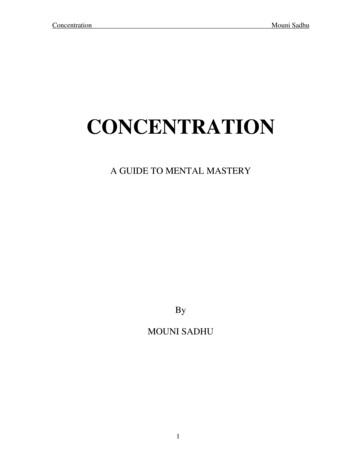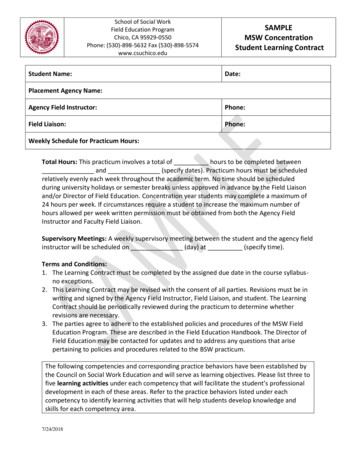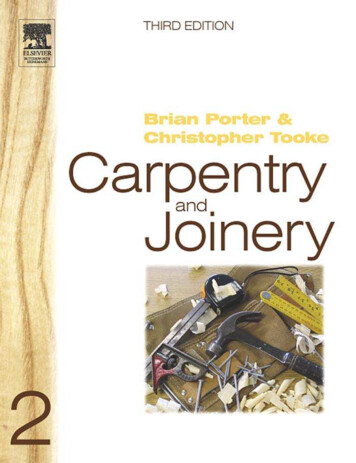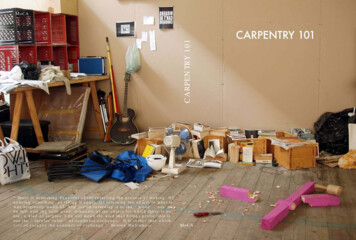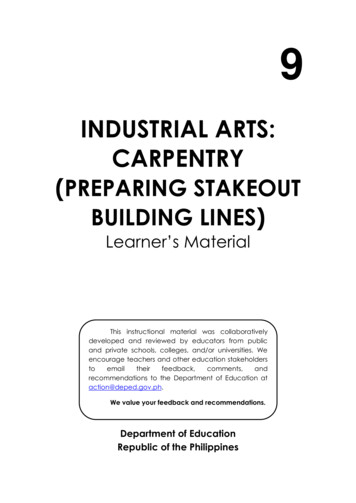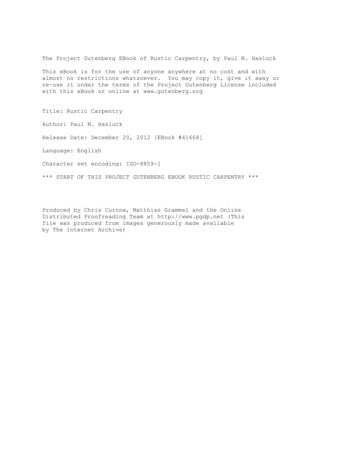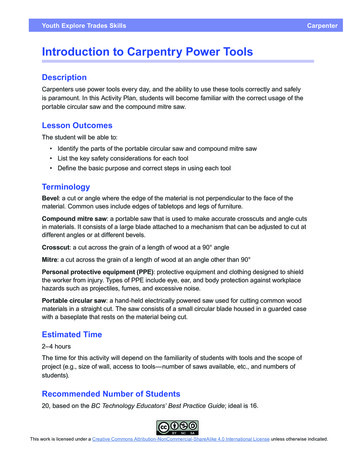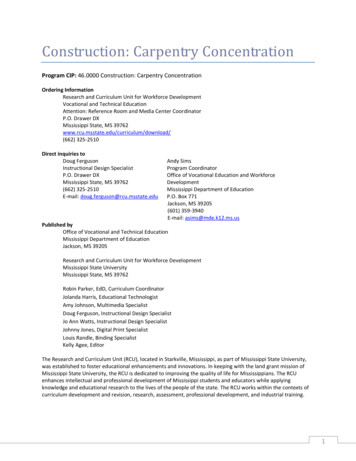
Transcription
Construction: Carpentry ConcentrationProgram CIP: 46.0000 Construction: Carpentry ConcentrationOrdering InformationResearch and Curriculum Unit for Workforce DevelopmentVocational and Technical EducationAttention: Reference Room and Media Center CoordinatorP.O. Drawer DXMississippi State, MS 39762www.rcu.msstate.edu/curriculum/download/(662) 325-2510Direct inquiries toDoug FergusonInstructional Design SpecialistP.O. Drawer DXMississippi State, MS 39762(662) 325-2510E-mail: doug.ferguson@rcu.msstate.eduAndy SimsProgram CoordinatorOffice of Vocational Education and WorkforceDevelopmentMississippi Department of EducationP.O. Box 771Jackson, MS 39205(601) 359-3940E-mail: asims@mde.k12.ms.usPublished byOffice of Vocational and Technical EducationMississippi Department of EducationJackson, MS 39205Research and Curriculum Unit for Workforce DevelopmentMississippi State UniversityMississippi State, MS 39762Robin Parker, EdD, Curriculum CoordinatorJolanda Harris, Educational TechnologistAmy Johnson, Multimedia SpecialistDoug Ferguson, Instructional Design SpecialistJo Ann Watts, Instructional Design SpecialistJohnny Jones, Digital Print SpecialistLouis Randle, Binding SpecialistKelly Agee, EditorThe Research and Curriculum Unit (RCU), located in Starkville, Mississippi, as part of Mississippi State University,was established to foster educational enhancements and innovations. In keeping with the land grant mission ofMississippi State University, the RCU is dedicated to improving the quality of life for Mississippians. The RCUenhances intellectual and professional development of Mississippi students and educators while applyingknowledge and educational research to the lives of the people of the state. The RCU works within the contexts ofcurriculum development and revision, research, assessment, professional development, and industrial training.1
Copyright 2007 by the Research and Curriculum Unit for Workforce Development, Vocationaland Technical Education (RCU). All rights reserved. Materials of this guide are intended for use inclassrooms, meetings, professional development opportunities, workforce developmentopportunities, and school community gatherings. For this purpose, materials in this frameworkmay be reproduced. Any other use of these materials is prohibited unless written permission isgranted by the RCU.2
Table of ContentsAcknowledgments. 5Preface . 7Executive Summary. 8Blueprint . 13Research Synopsis . 14Construction: Carpentry Concentration . 18Unit 1: Introduction and Orientation . 18Unit 2: Basic Safety . 31Unit 3: Basic Math . 50Unit 4: Hand and Power Tools. 59Unit 5: Introduction to Blueprints . 67Unit 6: Introduction to Carpentry . 72Unit 7: Introduction to Electrical Wiring . 82Unit 8: Introduction to Masonry . 92Unit 9: Introduction to Plumbing . 102Unit 10: Orientation (Review and Reinforcement) . 110Unit 11: Basic Safety (Review and Reinforcement) . 122Unit 12: Construction Math. 140Unit 13: Introduction to Materials Used in Construction . 143Unit 14: Footing, Foundation, and Floor Framing . 153Unit 15: Wall, Ceiling, and Roof Framing . 162Unit 16: Windows, Doors, and Stairs. 170Student Competency Profile for Construction: Carpentry Concentration . 181Recommended Tools and Equipment . 184Appendix A: 21st Century Skills Standards . 1893
Appendix B: Mississippi Academic Standards . 190Appendix C: ACT College Readiness Standards . 197Appendix D: National Industry Standards. 210Appendix E: National Educational Technology Standards for Students . 2204
AcknowledgmentsThe Construction Technology curriculum was presented to the Mississippi Board of Education on April17, 2008. The following persons were serving on the state board at the time:Dr. Hank M. Bounds, Executive SecretaryMr. Claude Hartley, ChairMr. William Harold Jones, Vice ChairMr. Howell “Hal” N. GageDr. O. Wayne GannMs. Rebecca HarrisMr. Charles McClellandMs. Sondra Parker CaillavetMs. Rosetta RichardsDr. David SistrunkMike Mulvihill, Interim Associate State Superintendent of Education for the Office of VocationalEducation and Workforce Development, at the Mississippi Department of Education assembled anoversight committee to provide input throughout the development of the Construction TechnologyCurriculum Framework and Supporting Materials. Members of this task force were as follows:John Bass, Mississippi Manufacturing AssociationMike Barkett, Mississippi Construction Education FoundationSam Davis, Mississippi Department of EducationAndy Sims, Mississippi Department of EducationDr. Bob Fuller, Starkville Public SchoolsJames Ivy, Northrop GrummanSarah Lay, Student, Vicksburg, MSDr. Edward C. Mann, University of Southern MississippiJennifer Marshall, Viking CorporationJackie McElwain, Kosciusko Public SchoolsMike McCullough, East Mississippi Community CollegeDarnell Ramshur, Carl Loftin Vocational CenterKirk Sullivan, Simpson County Vocational CenterMeda Vassar, Pontotoc County School DistrictMinadene Waldrop, Rankin County SchoolsJo Ann Watts, Research and Curriculum UnitDoug Ferguson, Research and Curriculum UnitHaley Weeks, Petal Vocational CenterBill Welch, Mississippi Department of EducationMaurice Whalen, Clinton Career ComplexLisa White, Carl Loftin Vocational CenterAlso, a special thanks is extended to the teachers who contributed teaching and assessment materialsthat are included in the framework and supporting materials. Members who contributed were asfollows:5
Barry Evans, Hinds Community College, RankinSteve Hurdle, Oxford-Lafayette School of Applied Technology, OxfordMarvin Moak, Hinds Community College, RaymondEdna Nelson, Greenwood Career Center, GreenwoodDarnell Nunn, Humphreys County Vocational Center, BelzoniWoodrow Price, Martin Luther King Career Technology Center, WoodvilleHowie Schiedel, Meridian Community College, MeridianLarry Stewart, Jackson Career Development Center, JacksonAppreciation is expressed to the following staff members at the Mississippi Department of Educationwho provided guidance and insight throughout the development process:Andy Sims, Program Coordinator, Office of Vocational Education and Workforce Development,Mississippi Department of EducationChris Wall, Director of Instructional Programs and Student Organizations, Office of VocationalEducation and Workforce Development, Mississippi Department of EducationFinally, standards in the Construction Technology Curriculum Framework and Supporting Materials arebased on the following:Contren Learning Series from the National Center for Construction Education and ResearchReprinted with permission from Contren Learning Series, Copyright 2002, National Center forConstruction Education and Research, (352) 334-0920, http://www.nccer.org/index.aspApplied Academic Credit BenchmarksMississippi Department of Education 2007 Mississippi Mathematics Framework Revised21st Century Skills and Information and Communication Technologies Literacy StandardsIn defining 21st century learning, the Partnership for 21st Century Skills has embraced fivecontent and skill areas that represent the essential knowledge for the 21st century: globalawareness; civic engagement; financial, economic, and business literacy; learning skills thatencompass problem-solving, critical-thinking, and self-directional skills; and Information andCommunication Technology (ICT) literacy.National Educational Technology Standards for StudentsReprinted with permission from National Educational Technology Standards for Students:Connecting Curriculum and Technology, Copyright 2007, ISTE (International Society forTechnology in Education), (800) 336-5191 (U.S. and Canada) or (541) 302-3777 (International),iste@iste.org, www.iste.org. All rights reserved. Permission does not constitute an endorsementby ISTE.ACT College Readiness StandardsThe College Readiness Standards are sets of statements intended to helpstudents understand what is expected of them in preparation for theACT. These standards are integrated into teaching and assessmentstrategies throughout the curriculum framework.6
PrefaceSecondary vocational–technical education programs in Mississippi are faced with many challengesresulting from sweeping educational reforms at the national and state levels. Schools and teachers areincreasingly being held accountable for providing true learning activities to every student in theclassroom. This accountability is measured through increased requirements for mastery and attainmentof competency as documented through both formative and summative assessments.The courses in this document reflect the statutory requirements as found in Section 37-3-49, MississippiCode of 1972, as amended (Section 37-3-46). In addition, this curriculum reflects guidelines imposed byfederal and state mandates (Laws, 1988, ch. 487, §14; Laws, 1991, ch. 423, §1; Laws, 1992, ch. 519, §4eff. from and after July 1, 1992; Carl D. Perkins Vocational Education Act IV, 2007; and No Child LeftBehind Act of 2001).7
Construction: Carpentry Executive SummaryProgram DescriptionConstruction is a program or an instructional program that prepares students for employment orcontinued education in the occupations of carpentry. The curriculum framework for this program wasdeveloped in partnership with the Mississippi Construction Education Foundation (MCEF). MCEF is theaccredited sponsor for the National Center for Construction Education and Research (NCCER).When developing this curriculum, writers recognized the importance of differentiating instruction andmeeting the needs of the 21st century learner. Teaching strategies included a blend of online and faceto-face instruction. Teaching strategies are aligned with Contren Connect e-books, online lectures, videopresentations, online quizzes, active figures, and Spanish content. Students will have access to thisinformation to learn new content as well as review, reinforce, or revise work.Industry CertificationThe NCCER developed and published a set of industry standards that are taught nationwide bycontractors, associations, construction users, and secondary and postsecondary schools called theContren Learning Series. When developing this set of standards, the NCCER assembled a team ofsubject matter experts that represented construction companies and schools across the nation. Eachcommittee met several times and combined experts’ knowledge and experience to finalize the set ofnational industry standards.As a part of the accreditation process, all Mississippi construction instructors will be required tosuccessfully complete the Instructor Certification Training Program. This program ensures thatinstructors possess a deep knowledge of content of the standards.This state-of-the-art curriculum is modeled after the eight Mississippi NCCER Accredited Training andEducation Facilities (ATEF). In order to become an NCCER ATEF program, school districts must meet aset of guidelines including the following:1. Use the approved curriculum.2. All instructors must be NCCER certified.3. All completed Form 200s and release forms on all student completions are to be forwarded toM
Mr. Claude Hartley, Chair Mr. William Harold Jones, Vice Chair Mr. Howell “Hal” N. Gage Dr. O. Wayne Gann Ms. Rebecca Harris Mr. Charles McClelland Ms. Sondra Parker Caillavet Ms. Rosetta Richards Dr. David Sistrunk Mike Mulvihill, Interim Associate State Superintendent of Education for the Office of Vocational Education and Workforce Development, at the Mississippi Department of Education .
